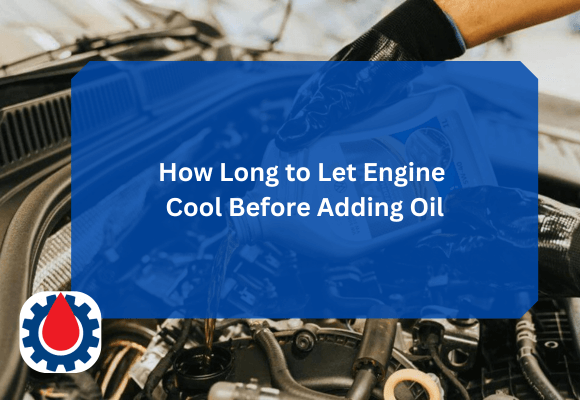How long should you let your engine cool before adding oil? Doing this correctly ensures safety, accuracy, and the health of your engine. In this post, we’ll explore why letting your engine cool matters, how long it typically takes, and best practices for adding oil safely and effectively.
How Long to Let Engine Cool Before Adding Oil
You should wait at least 15 to 30 minutes after turning off your engine before adding or checking oil, as this allows the engine to cool to a safe temperature and the oil to fully settle in the pan for an accurate reading. For smaller top-offs, a shorter wait of 5–10 minutes may be acceptable, but after long drives or with larger engines, waiting up to an hour is safer to avoid burns and ensure proper oil circulation.
Related Engine Tick After Oil Change(5 Causes + Solutions)
Why Engine Cooling Matters Before Adding Oil
Adding oil to a hot engine can be risky for several reasons. First, safety is a concern. A hot engine can cause burns if you accidentally touch hot components or if oil splashes. Second, adding oil to a hot engine can affect the accuracy of the oil level reading.
When an engine is hot, the oil expands, and some of it may still be circulating or clinging to engine components, leading to a false dipstick reading. Finally, pouring cold oil into a hot engine can cause thermal shock, which, while rare, could potentially damage engine parts.
Related Normal Oil Pressure for Diesel Engines(Norma Pressure Range)
How Long to Let Your Engine Cool
The cooling period depends on what you want to do with the oil:
1. Topping Off Engine Oil
If you just want to add oil to bring the level up:
- Wait about 5–10 minutes after shutting off the engine.
- This gives the oil enough time to drain back into the oil pan and cool down slightly without becoming too thick.
- The dipstick will provide a more accurate reading, and the oil you add will mix properly with the existing oil.
2. Checking Oil Level
When checking your oil level with the dipstick:
- Most manufacturers recommend checking when the engine is warm but not hot.
- Waiting 10–15 minutes after driving is ideal. The oil will settle in the pan, giving you a correct measurement.
3. Full Oil Change
If you are draining and replacing the oil completely:
- It’s best to let the engine run for a few minutes before shutting it off. Warm oil flows out more easily than cold oil, which helps ensure a cleaner drain.
- After shutting off the engine, wait about 5 minutes before removing the drain plug. The oil will still be warm (not dangerously hot) and thin enough to flow out smoothly.
Related Oil Change Interval Calculator
Risks of Adding Oil to a Hot Engine
Adding oil while the engine is too hot can cause several problems:
- Safety hazard: You risk burns when touching hot components.
- Oil splash or smoke: Pouring cold oil into a hot engine may create smoke or splattering.
- Poor mixing: Fresh oil might not blend properly with the existing oil until temperatures stabilize.
On the other hand, adding oil when the engine is extremely cold is not dangerous, but it may take longer for the oil to circulate once you start the engine.
Related Engine Overheating After Oil Change(6 Causes + Solutions)
Best Practices for Adding Engine Oil
- Park on a Level Surface: Ensure your vehicle is on flat ground to get an accurate dipstick reading.
- Wait for the Engine to Cool: As mentioned, wait at least 15–30 minutes after turning off the engine. This ensures the oil has settled and the engine is safe to work on.
- Pop the Hood: Open the hood and locate the dipstick and oil filler cap. The dipstick is usually marked with a bright handle, and the oil filler cap is typically labeled with the oil grade (e.g., 5W-30).
- Check the Oil Level: Remove the dipstick, wipe it clean with a rag, reinsert it fully, and then pull it out again to check the oil level. If the level is below the “low” mark, you need to add oil.
- Add Oil Gradually: Use a funnel to pour oil into the oil filler cap. Add small amounts at a time (e.g., a quarter of a quart), then wait a minute for the oil to settle before checking the dipstick again. Avoid overfilling, as this can harm the engine.
- Recheck the Oil Level: After adding oil, check the dipstick again to ensure the level is within the recommended range (between the “low” and “full” marks).
- Secure Everything: Replace the oil filler cap and dipstick, and close the hood.
Related Does Service Engine Soon Mean Oil Change(Explained)
Lawn Mowers and Small Engines
For small engines like lawn mowers, generators, and tractors, the same principle applies:
- Let the machine cool for 5–10 minutes before adding or checking oil.
- If performing an oil change, allow it to run briefly before shutting down so the oil warms up and drains more easily.
These small engines typically heat up faster than cars, so waiting too long may cause the oil to thicken again.
Seasonal Considerations
Temperature and climate also affect oil behavior:
- Hot weather: Oil stays thin longer, so a shorter wait (5–10 minutes) is enough.
- Cold weather: Oil thickens quickly, so waiting a little longer (10–15 minutes) helps ensure accurate measurements.
Related White Stains Engine Splatter After Oil Change(4 Causes + Solutions)
FAQs
How long should you let your engine cool before adding oil?
Typically, 15–30 minutes is enough for topping off. This ensures the oil has settled and cooled slightly for safe handling.
Can you add oil while the engine is still warm?
Yes, as long as it’s not extremely hot. A slightly warm engine actually helps the oil mix better.
Is it bad to add oil to a hot engine?
Yes, it can be unsafe and may cause oil to splash, smoke, or fail to mix properly. Always let it cool for at least a few minutes.
Should you check oil when the engine is hot or cold?
Check oil when the engine is warm but not hot, usually 10–15 minutes after shutting it off. Cold readings may be less accurate.
How long should I wait to change oil after driving?
Wait about 5 minutes after turning off the engine. The oil will still be warm enough to drain efficiently without being dangerously hot.




